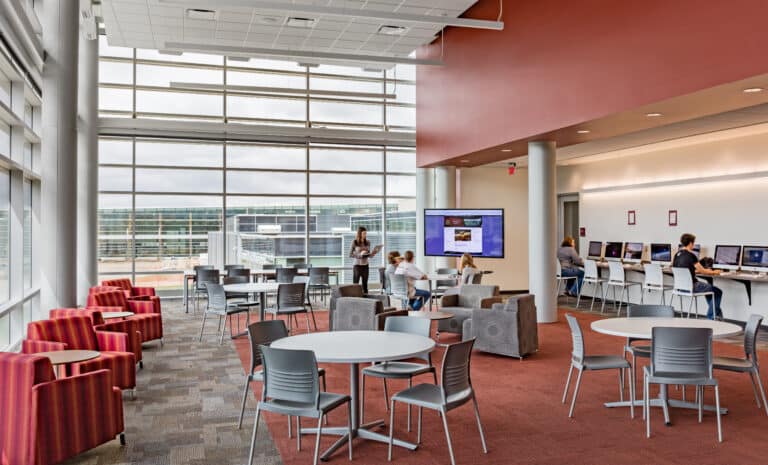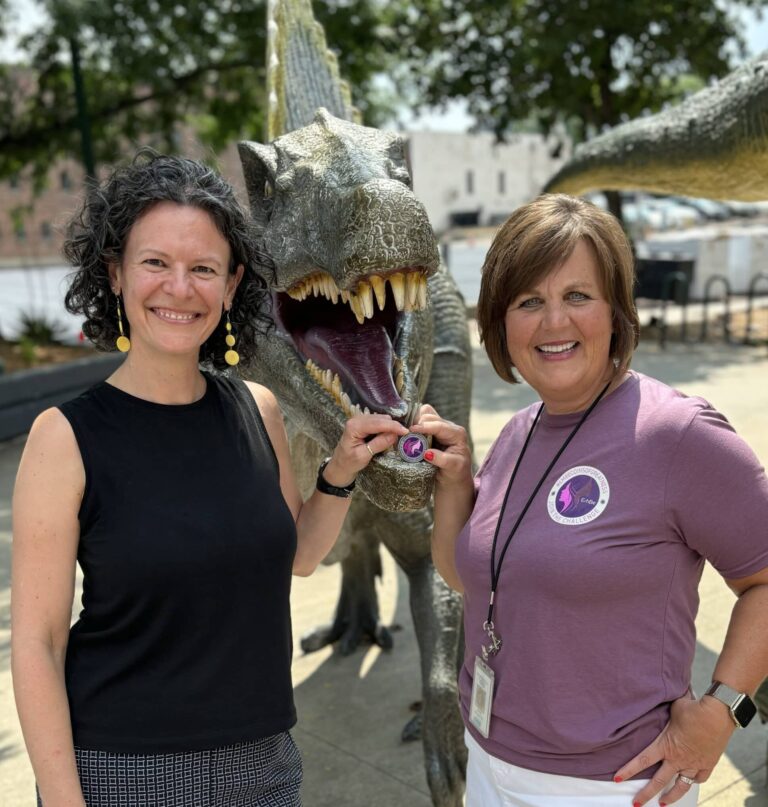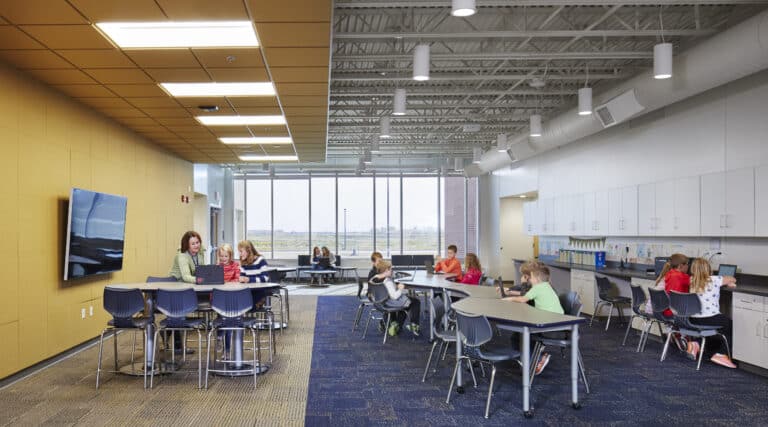DRIVING CHANGE IN EDUCATION
The next generation of learners were born into a world ruled by intuitive devices, interconnectivity, and platforms ripe with instant information and discovery — all at their fingertips. You could say, today’s K12 students are not even “programmed” for the same approaches that worked with past generations of learners. They are looking for more realistic workforce training, collaborative learning, cutting-edge technology, sustainably responsible buildings, and energized environments that can keep up with their evolving interests. All of this is challenging educators to anticipate their quickly changing needs and adapt their plans on the fly.
Discussion on the changes in education and the impact on the built environment have been building momentum over the last decade with conversations about pedagogy, building design, security, and technology at the forefront. Today, conversations around mental health, human interaction, and social emotional well-being are rising to the top and driving change around how we talk about and embrace these student and staff needs. In short, formalized education is embarking on a future-ready overhaul that responds to the ambitions of the next generation.
“Our students are entering a world that we can’t envision and will be in occupations that do not even exist yet, so focusing on skills that will provide them success, goes beyond just delivering academic content.“
– Kay Nelson, Former Assistant Superintendent, Sartell-St. Stephen Schools
NAVIGATING CHANGE
If you’re wondering when these changes are coming, the simple answer is, yesterday. Change is already here and knocking on your door. Schools are being charged with giving teachers, students, and administration the tools to embrace life and learning beyond the walls of the traditional classroom. Planning for the future requires robust, flexible, infrastructure that is prepared to meet the changing needs for decades to come —even if we don’t know exactly what that looks like. Your building can help you navigate some of the changes you may be encountering and help you prepare for an unpredictable future.
- Be in alignment with the community.
The beliefs, values, and expectations of the community can impact the success or failure of an implemented change. The space within your building is a great opportunity to support local needs and reflect the diverse cultures of the people who use it. A thriving local business could be a great partner for a coffee shop or career and technical education program. Additional athletic space can supplement community recreation space and be a place for gathering. In Mahnomen, MN, a discussion on the mental health needs for staff and students is the driving force. They’re considering providing space for wrap-around services that increase access to mental and physical health resources within the building. In this scenario, students wouldn’t have to leave campus to benefit from those services, resulting in less instructional time loss.
When asked what one piece of advice he would give to other education leaders who are managing changes in their school, Superintendent of McKenzie County School District, Steve Holen, noted that it’s important to “…maintain levels of communication and transparency by ensuring the changes are aligned with community beliefs and expectations. Collaboration with other political subdivisions and businesses is essential to ensure the school district has a similar expectation as stakeholders and citizens in the community.” - Make change part of school culture.
Educators and employers are asking students to be collaborative, creative, critical thinkers, and good communicators — skill sets often referred to as the “Four C’s.” A fifth “C” to add to that list is students who can navigate Change. Change is part of the unlearning and relearning process that is now a coveted character asset. Modern facilities demand spaces that can flex with pedagogical, enrollment, and drastic world changes. Over the last two years, those who had integrated technology and modernized spaces were able to pivot with the unexpected changes more quickly. Those who still leaned on traditional learning environments found making the changes more challenging, and often were less able to support the technology and spatial needs of students in schools that were not designed to adapt. When adaptability is part of the everyday, navigating change is less intimidating and creates more resilient educators and learners.
“Just like instruction needs to change, our learning environments also need to change,” said Kay Nelson, Former Assistant Superintendent for Sartell-St. Stephen Schools. “Students no longer learn in desks and rows. They need open spaces and flexibility to embrace collaboration and problem-solving situations. Spaces that foster creativity and allow for a variety of learning styles are essential to meaningful learning. This is what we see in business and industry, and our schools should model the workplace if we are truly preparing our students for life beyond our school walls. Facilities should inspire, make learning visible, and celebrate the opportunities the school provides.” - Be purposeful and model expectations.
As with anything unknown, a building that challenges the status quo can be emotional and create apprehension, mistrust, anxiety, and fear. It’s common for people to be hesitant to embrace change, preferring to stick with what they know and what has always been done, regardless of its effectiveness. Your building should not get in the way but rather reinforce your school’s mission and driving pedagogy. As you develop your pedagogy, be purposeful in setting expectations for staff and help them understand how the building can support their goals. Show them how it can flex to respond to changes as yet unknown. Open and engaging conversations with both your designers and your staff ensure the building, teaching, and learning work together to maximize potential now, and in the future. - Maintain clear, consistent communication and transparency.
A new building, or the transformation that an existing building goes through during renovation, can be an opportunity to adjust procedure and provide spaces that present new opportunities for teaching and learning. Use the time during design and construction, which can be anywhere from a year to several years, to communicate the why behind the changes going into effect and how the building supports that. Effectively managing institutional change is a matter of balancing perspective and expectation. It’s critical to make sure that stakeholders feel informed about what is happening, and most importantly, why something is happening. Clear, consistent communication helps keep everyone informed. Nelson recognizes the importance of communicating change to staff, saying, “Change is the only constant, and this is challenging for educators. Educational changes take time to be fully implemented and effective, so being deliberate and focused when tackling new initiatives is critical. When staff understand “the why”, they are more open to change.” - Plan and pilot professional development.
In this fast-paced digital age, spaces that foster creativity and allow for a variety of learning styles are now essential to meaningful learning and teaching. Part of communicating with staff to ensure they know what to expect, is incorporating time to experiment and learn through professional development programs. Provide time and space for staff to ask questions, try things out, and understand how a new idea can be incorporated into their lesson plans. Sometimes creating an actual “pilot learning space” that mimics the space to be provided, allows staff to work in a prototype of the proposed spaces that includes the technology that will be provided. This is a great way to not only make everyone comfortable with the change but allow them to relay meaningful feedback to the design team. Putting the extra effort into planning can help ensure a high probability of success when and if changes get implemented. Nelson had this advice for other education leaders who are managing changes in their school, “Be purposeful. Know the why behind the change, and make sure it is student-centered. Be impeccable with your word and make sure you are willing to roll up your sleeves and model what you are asking others to do.”
FUTURE READINESS
Navigating these conversations can be difficult, emotional, and ultimately exciting if districts are willing to embrace new ways of thinking and doing. When you need to quickly adapt to changes, the building shouldn’t be a barrier to your goals. Your building can support your goals and be part of the solution to navigating the changes your district may be facing. When building and pedagogy are in sync, change can be uplifting and a catalyst to a new outlook and new opportunities that demonstrate your school is listening, adapting, and ready to take on the future of education.
“We have tried to be transparent and consistent in our management of change; we believe strongly in having a well-researched, flexible plan to allow for levels of adjustment as needed to maintain the overall, long-range goals established in conjunction with stakeholders.”
– Steve Holen, Superintendent, McKenzie County School District





